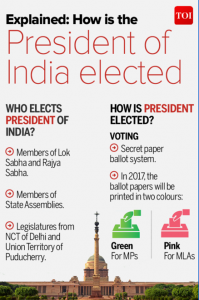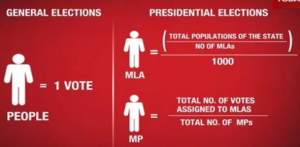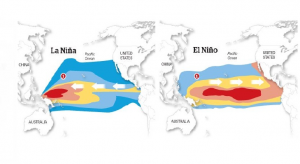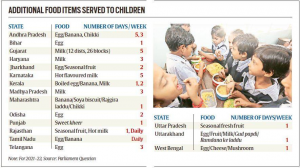THE INDIAN POLITY
1. EXPLAINED: THE PROCESS OF ELECTING INDIA’S PRESIDENT
THE CONTEXT: The tenure of the current President of India is set to end in July this year(2022), which is also when the 16th Indian Presidential election will be held to elect his successor.
THE EXPLANATION:
How is the President elected?
- The Indian President is elected through an electoral college system, wherein the votes are cast by national and State-level lawmakers. The elections are conducted and overseen by the Election Commission (EC) of India.

- The electoral college is made up of all the elected members of the Upper and Lower Houses of Parliament (Rajya Sabha and Lok Sabha MPs), and the elected members of the Legislative Assemblies of States and Union Territories (MLAs).
- This means, in the upcoming polls, the number of electors will be 4,896 — 543 Lok Sabha MPs, 233 MPs of the Rajya Sabha, and 4,120 MLAs of all States, including the National Capital Territory (NCT) of Delhi and Union Territory of Puducherry.
- Before the voting, comes the nomination stage, where the candidate intending to stand in the election, files the nomination along with a signed list of 50 proposers and 50 seconders. These proposers and seconders can be anyone from the total of 4,896 members of the electoral college from the State and national levels.
What is required to secure a victory?
- A nominated candidate does not secure victory based on a simple majority but through a system of bagging a specific quota of votes. While counting, the EC totals up all the valid votes cast by the electoral college through paper ballots and to win, the candidate must secure 50% of the total votes cast + 1.
- Unlike general elections, where electors vote for a single party’s candidate, the voters of the electoral college write the names of candidates on the ballot paper in the order of preference.
What is the value of each vote and how is it calculated?
A vote cast by each MP or MLA is not calculated as one vote. There is a larger vote value attached to it.
The fixed value of each vote by an MP of the Rajya Sabha and the Lok Sabha is 708. Meanwhile, the vote value of each MLA differs from State to State based on a calculation that factors in its population vis-a-vis the number of members in its Legislative Assembly. As per the Constitution (Eighty-fourth Amendment) Act 2001, currently, the population of States is taken from the figures of the 1971 Census. This will change when the figures of the Census taken after the year 2026 are published.

THE WORLD GEOGRAPHY: CLIMATOLOGY
2. NO EL NINO EXPECTED, IT WILL BE A ‘NORMAL’ MONSOON, SAYS SKYMET
THE CONTEXT: According to Skymet, the southwest monsoon 2022 will likely be “normal”, though rainfall in August, the second rainiest month, will likely be subdued.
THE EXPLANATION:
- “Normal”, according to Skymet, is 98% of the historical average of 88 cm for the four-month stretch from June-September. Rajasthan, Gujarat, Nagaland, Manipur, Mizoram and Tripura are likely to be rain deficit throughout the season. The northeastern states have a high base level of rainfall.
- In the South, Kerala and north interior of Karnataka would see subdued rainfall in the core monsoon months of July and August. On the other hand, Punjab, Haryana, and Uttar Pradesh — key Kharif crop regions — and rainfed areas of Maharashtra and Madhya Pradesh would witness “above normal”’ rainfall, the agency stated.
- The El Nino, characterized by a warming of temperatures in the Central Pacific and associated with drying up rainfall over India, wasn’t expected to surface this year. Its converse, or a La Nina, had helped with two years of above-normal rainfall in 2019, 2020 and “normal” rain in 2021.
- “The last two monsoon seasons have been driven by back-to-back La Nina events…the occurrence of El Nino, which normally corrupts the monsoon, is ruled out.
Indian Ocean dipole
- Another factor that influences monsoon was the Indian Ocean dipole, whose “positive” phase corresponded to good rains and “negative” the opposite. “The Indian Ocean Dipole is neutral, albeit having a propensity of negative inclination… Monsoon will have to ride over ENSO — neutral conditions, while battling resistance from IOD, especially during the 2nd half of the season. This possibly can lead to extreme variability in the monthly rainfall distribution,” the agency said.
- The first half of the monsoon — June and July — was expected to be better than the second. June was expected to get 7% more rain than what’s usual, July 100%, August 95% and September, when the monsoon starts to wane, 90%. The last few years, however, have seen unusually high rains in September.
- The India Meteorological Department (IMD), which issues the official forecast, is expected to announce its first forecast for the season later this week. The agency follows a multiple-stage forecast system with an update in June.
VALUE ADDITION
- El Niño: A warming of the ocean surface, or above-average sea surface temperatures (SST), in the central and eastern tropical Pacific Ocean. Over Indonesia, rainfall tends to become reduced while rainfall increases over the tropical Pacific Ocean. The low-level surface winds, which normally blow from east to west along the equator (“easterly winds”), instead of weakening or, in some cases, start blowing the other direction (from west to east or “westerly winds”).
- La Niña: A cooling of the ocean surface, or below-average sea surface temperatures (SST), in the central and eastern tropical Pacific Ocean. Over Indonesia, rainfall tends to increase while rainfall decreases over the central tropical Pacific Ocean. The normal easterly winds along the equator become even stronger.
- Neutral: Neither El Niño or La Niña. Often tropical Pacific SSTs are generally close to average. However, there are some instances when the ocean can look like it is in an El Niño or La Niña state, but the atmosphere is not playing along (or vice versa).

THE SOCIAL ISSUES AND SOCIAL JUSTICE
3. EXPLAINED: MIDDAY MEAL AND SUPPLEMENTS
THE CONTEXT: From the next academic session, Karnataka is likely to become the 13th state to provide eggs under the midday meal scheme, which is among the largest initiatives in the world to enhance the nutrition levels of school-going children through hot cooked meals.
THE EXPLANATION:
- The proposal, which faces opposition and awaits the Karnataka government’s final stamp of approval, comes on the back of successive surveys pointing out the high prevalence of malnutrition, anemia and low immunity among children in many parts of the state, where the National Family Health Survey-V found 35% children under five stunted, and around 20% wasted.
- The current version of the programme, renamed PM Poshan Shakti Nirman or PM Poshan in 2021, traces its roots to 1995; it was launched as a centrally sponsored scheme on August 15 that year across 2,408 blocks for students up to Class 5. In 2007, the UPA government expanded it to Class 8.
- However, the first initiative to provide meals to children had been taken by the erstwhile Madras Municipal Corporation around 1920. In post-Independence India, Tamil Nadu was again the pioneer, with Chief Minister K Kamaraj rolling out a school feeding scheme in 1956. Kerala had a school lunch scheme run by a humanitarian agency since 1961. The state government officially took over the initiative on December 1, 1984, making Kerala the second state in the country to have a school lunch programme. Over the next few years, many other states launched their own versions of the scheme, and finally, in 1995, the Centre stepped in.

What is the scale of the scheme today?
- The scheme covers 11.80 crore children across Classes 1 to 8 (age group 6 to 14) in11.20 lakh government and government-aided schools and those run by local bodies such as the municipal corporations in Delhi under the provisions of the National Food Security Act, 2013 (NFSA).
- In the Budget for 2022-23, the Centre has earmarked Rs 10,233 crore for the scheme, while the states are expected to spend Rs 6,277 crore. It is not just a scheme, but a legal entitlement of all school-going children in primary and upper primary classes, through the National Food Security Act (NFSA), 2013, as well as the Supreme Court’s ruling in the People’s Union of Civil Liberties vs Union of India and Others (2001).
Do the Centre and states run the scheme jointly?
- Under the rules, the allocation of Rs 4.97 per child per day (primary classes) and Rs 7.45 (upper primary) are shared in a 60:40 ratio with states and UTs with a legislature, and 90:10 with the Northeastern states, Jammu and Kashmir, Himachal Pradesh and Uttarakhand, while the Centre bears 100% of the costs in UTs without legislature.
- But the states and UTs that supplement the meals with additional items such as milk and eggs contribute more. Components such as payments to cooks and workers are also split in the same ratio between the Centre and states. However, the Centre bears the entire cost of foodgrains and their transportation and also handles the expenditure on management, monitoring and evaluation of the scheme.
THE INDIAN ECONOMY
4. EXPLAINED: HOW WILL THE CARDLESS CASH WITHDRAWAL SYSTEM AT ATMS WORK?
THE CONTEXT: India’s central bank announced cardless cash withdrawals at ATMs in the country. The feature will let consumers use the Unified Payment Interface (UPI) on their smartphones to withdraw cash from ATMs.
THE EXPLANATION:
How will this system work?
- Cardless cash withdrawals are to be authenticated via UPI. So, ATMs are expected to show an option for withdrawing cash using UPI. Once a user selects this option, they can input the amount to be withdrawn. A QR code will be generated on the ATM.
- Users will then need to scan that code via their UPI app and enter the password to withdraw cash from the ATM. Until now, only fund transfers between accounts were enabled via UPI. With this option, consumers can take cash out from ATMs without a card.
What issues does this tech solve?
- According to the RBI Governor, cardless cash withdrawals will enhance the security of cash withdrawal transactions. Besides, it would help prevent frauds like card skimming and card cloning.
- Currently, only existing customers of a few banks are allowed to withdraw cash without cards, and from specific bank’s ATM networks. However, RBI’s move to allow interoperability in cardless withdrawals will enable users to take cash from any all bank’s ATM.
- RBI’s move will invite more players into the payment ecosystem in India to innovate and solve further problems of customers.
What is card skimming?
- Criminals steal data from credit or debit cards by tracking a card swiped at ATMs. They pick this information using a skimming device that reads the card’s magnetic strip. These devices are surreptitiously installed on ATMs. And once the device picks up the data, it can be used to gain unauthorized access to the user’s banking records.
- The stolen information can be coded onto a new card, a process called cloning, and be used to make payments and transact with other bank accounts. Problematic ATMs that function intermittently and the ones located in isolated areas are often used to install such skimming devices.
- Fraudsters also install scanning devices on point of sale machines. These devices can stealthily scan a card before it is swiped at the payment counter at a departmental store. This is especially tough to spot if the billing counter is not in the line of sight of the card owner.
- These devices are difficult to identify as they appear to be a legitimate part of an existing ATM, or like a regular in-store card reader. It is skillfully fitted to the payment machines.
What is the future of debit cards?
- According to the statement, Issuing cards will not be stopped, as they have several other utilities beyond cash withdrawals. They can be used at a restaurant, shop, or for payments in a foreign country.
- The debit card is a very evolved financial product and has already gone through a lot of iterations to its perfection. In its further evolution, we are seeing new use cases for debit cards like having standing instructions or EMI payments.
THE ENVIRONMENT AND ECOLOGY
5. ODISHA’S BARBARA FOREST SET FOR ECOTOURISM PUSH
THE CONTEXT: According to the state forest officials, the Odisha’s Barbara forest is set to open for the public from the next tourist season in September 2022.
THE EXPLANATION:
- Odisha’s Barbara Forestdubbed as Asia’s largest teak and sal forest, the Barbara forest in Odisha was perhaps the only forest in India guarded by the jawans of the Central Reserve Police Force (for protecting forest resources).
- Spread over 870-sq km, the forest touches three districts Khordha, Nayagarh and Ganjam of Odisha and, as per legend, is named after a British forest officer’s wife, who was killed in a tiger attack in the area, 100-odd years ago.
- The dense teak forest, about 150 km from Bhubaneswar, lent to a flourishing timber market in Bhubaneswar, Berhampur, Cuttack and Nayagarh. It is said the timber mafia worked in tandem with the locals, prompting former Chief Minister Biju Patnaik to seek deployment of CRPF in 1994-95 to check tree felling and protect the forest.
- “The CRPF presence had instilled fear in the mind of timber smugglers and the immediate destruction of precious teak treasure was contained.
- Though the CRPF deployment in Barbara was initially for three years but given the continued threat from the timber mafia, the State Government kept extending the date. According to sources, the CRPF wanted to withdraw from Barbara forest due to its commitment in other parts of the State, where Maoist violence was on the rise. However, a non-government organization moved to Orissa High Court seeking to retain CRPF deployment. The Orissa High Court stayed CRPF’s withdrawal.
- Once the State government deployed Odisha Special Striking Force (OSSF), the CRPF withdrew in 2016. According to reports, about 1,000 timber smugglers were arrested and sawmills around the forest area were shut down during the first decade of CRPF deployment.
VALUE ADDITION:
About Barbara Forest:
- It is nature’s best-kept secret near Chilika Lake in coastal Odisha.
- It is named after a British woman, Barbara who had been killed by a tiger in the late 19th century while she was with her husband on a hunting expedition.
- The Barbara landscape is an enriched area that boasts several century-old plants sown by the British back in 1910.
- Giant squirrels are found in great numbers in the thick forests of Barbara, making it a major contender to become a sanctuary for giant squirrels.
- Barbara was once historically famous for its tigers, now one can find sambar, deer, mouse deer and bison.
THE PRELIMS PRACTICE QUESTIONS
QUESTION OF THE DAY
Q. Which of the following is not a part of the electoral college for the election of the President of India?
a) Elected members of the State Assembly
b) Elected members of Lok Sabha
c) Nominated members of Rajya Sabha
d) Elected Members of Rajya Sabha
ANSWER FOR 12TH APRIL 2022
Answer: D
Explanation:
- Gujarat has topped the list for larger States in the NITI Aayog’s State Energy and ClimateIndex–Round 1 that has ranked States and Union Territories (UTs) on six parameters.
- States have been categorized based on size and geographical differences as larger and smaller States and UTs.The index is based on 2019-20 data.
- Gujarat, Kerala and Punjab have been ranked as the top three performers in the category of larger States, while Jharkhand, Madhya Pradesh and Chhattisgarh were the bottom threeStates.
- Goa emerged as the top performer in the smaller States category followed by Tripura and Manipur. Among UTs, Chandigarh, Delhi and Daman & Diu/Da- dra& Nagar Haveli are the top performers. The SECI developed by NITI Aayog which includes 27 indicators under 6 parameters is expected to play a crucial role in pushing the states to adopt best practices and move the needle on clean energy transition.

